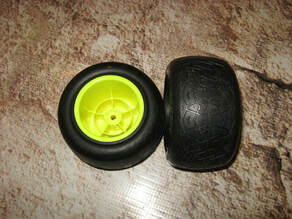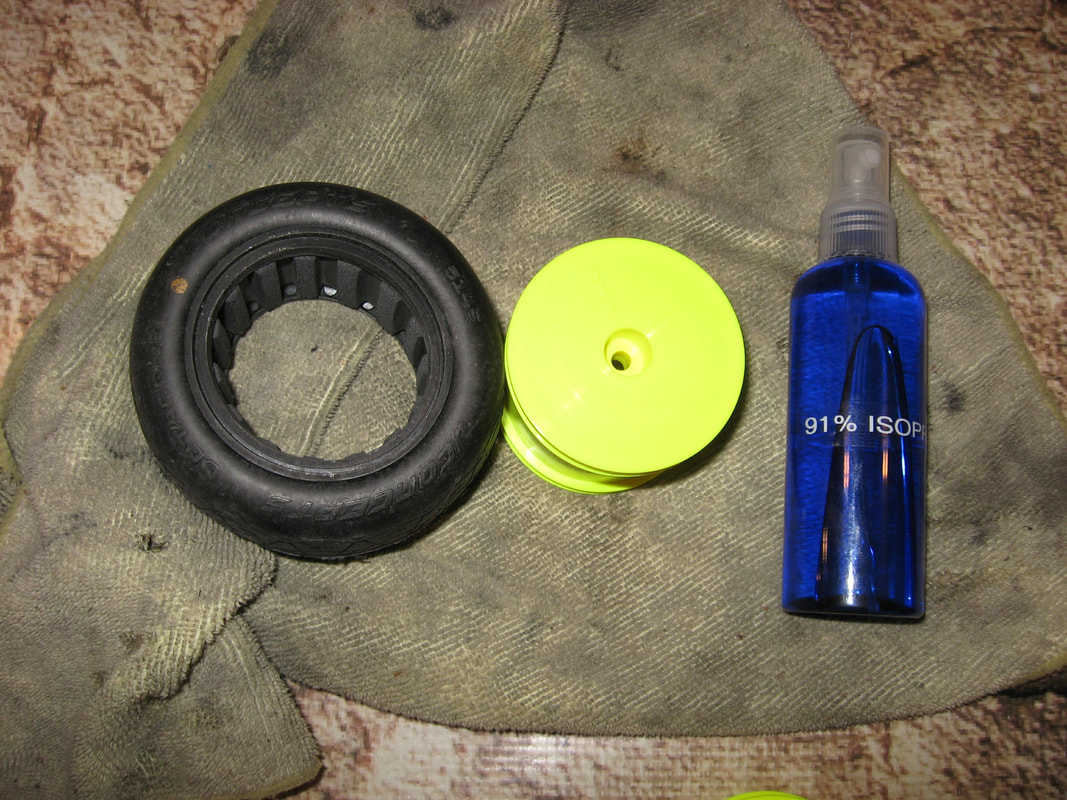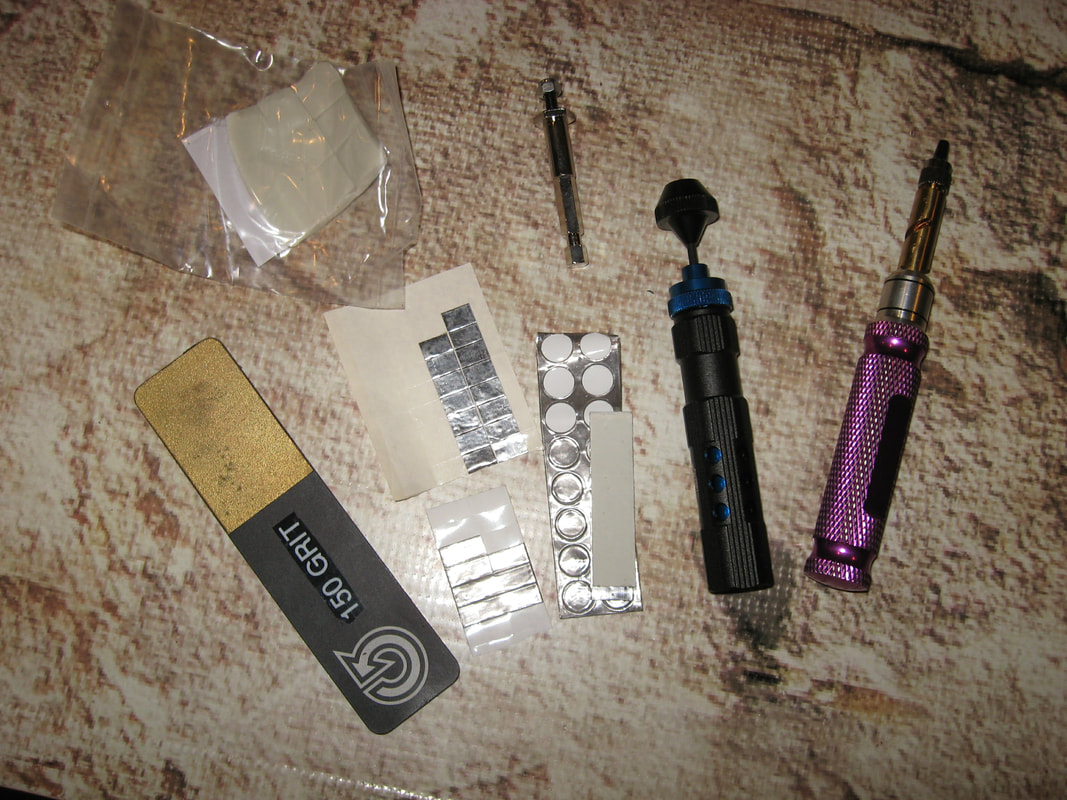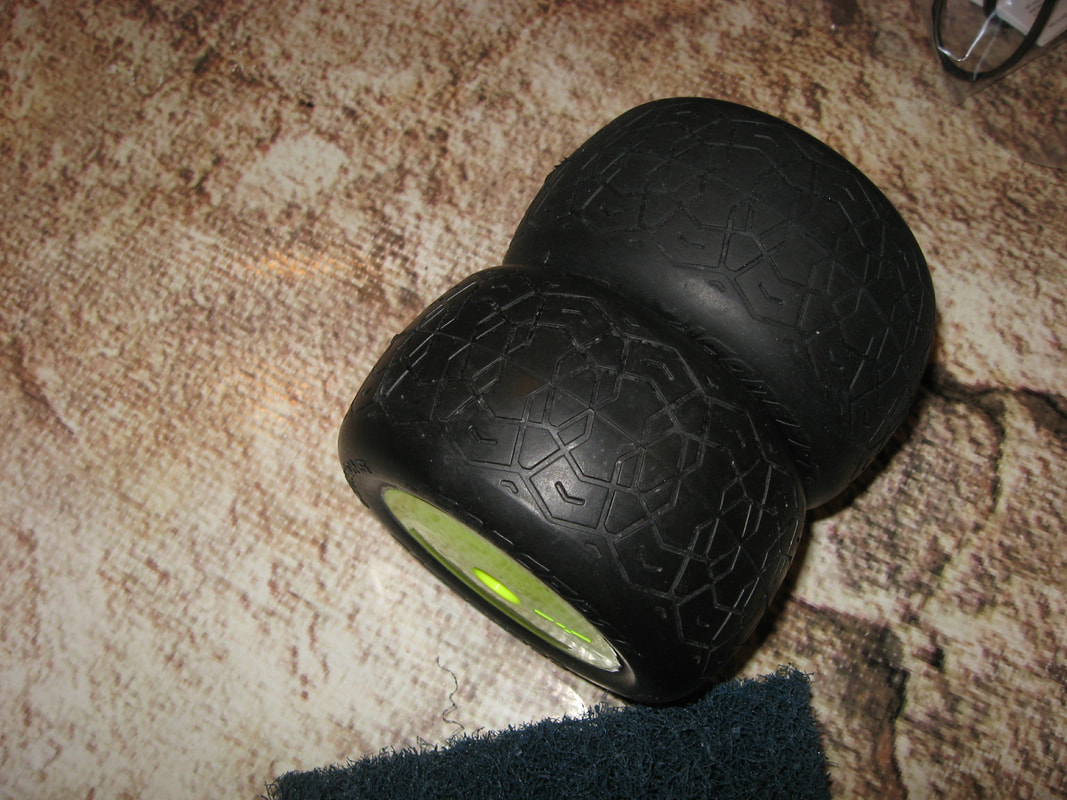|
Tires are by far the most important part of your RC racer. If your tires are not in contact with the racing surface, you may be fast, but not actually in control. Too often tire prep is neglected, "glue and go" just gets you going, not winning. As a note, safety glasses and gloves are recommended when dealing with any chemical or rotary tool. Tire SelectionI am not going to go into detail here on tire / insert selection, as it will vary from track to track. Ask the owner, ask the fast guys (or peek) what they are running, and pay attention to tire compound. There can be huge differences in tire performance, with only a minor change in rating (normally a manufacturer color code). This is not to say you should be scared to experiment, however, tires are costly and selecting multiple pairs of incorrect treads can financially set back your racing program. Once you know what tires work, stockpile a few sets of both your primary and secondary treads. Track conditions can and do change, and if attending large races local stock can be unobtainable, as the shelf goes bare. Tire Prep And GLuingTire prep and gluing are the most critical steps in tire preparation. Isopropyl alcohol should be used to clean both the tire and wheel mating surfaces. This will remove any mold release agents, and allow the glue to bond better. This will also stop most later peeling of the tire requiring re-gluing.  Once dry from the alcohol, a last double check of the insert should be done prior to placing on the wheel. Look for any defects or bunching, and correct as needed. Tire bead should be worked around and properly seated prior to gluing. Tread Direction and manufacture color dot should also be checked. It is very easy to glue tires facing opposite directions than intended (CA de-bonder is valuable if you have ever done this). The tire color code dot should be faced to the inside if possible, as this will decrease the likelihood of it wearing off. Many RC tire gluing tools and jigs have come and gone over the years, supposedly with the intent of making gluing easier. Some work well, but most do not. A clean work surface, a clean rag, and a set of quality rubber bands is all that is really needed.  Proper Cyanoacrylate (CA) glue should be used, and never the cheap kind, as it will most likely crack and not bond properly. This is not to say you can not use other non RC brands, but some thought should be given to thickness, drying time, and brittleness when dried. I find the thinner CA easier to work with and longer drying times are a must in case a mistake is made. Use the fine glue tips provided, trim as needed, and pick up spare tips, as they mostly are not easily reusable. For actual gluing, use a clean and disposable work surface (a clean towel), select a visual starting and ending point on one side, and slowly peel the rubber edge way. Insert the glue tip and start applying glue. Work your way quickly but not rushed in a circle applying glue to the outer bead of the tire carcass. Go slow, and use as little of the glue as needed. I apply a small amount and slowly allow the bead to seat again, this pushes the liquid glue ahead of the exposed bead and allows for a selection of how much glue is needed in the next section. Once completed, quickly wipe any excess glue, if your good there will not be any. Apply the rubber band to the tire and allow to totally dry. Once dry, remove the band and check for any sections missed, repeat as needed until you have the bond your are looking for. As a last step, I run a small bead along the edge where the tire meets the wheel, and roll it around the tire. This seals the edges from dirt and also fills any smaller areas that you may have missed. Repeat the above steps for both sides, insuring that the tires are dry prior to placing them on anything you value. RC Tire Balancing And VentingA lot of people do not take the time to balance or vent their racing tires, but the pros do. As with full size racing, any time the tire is not in contact with the racing surface you are not in control, and an out of balance tire can also lead to premature shock seal and suspension wear. Start by purchasing a quality balancer, mount and spin the tire. Once the tire stops spinning it will wobble to the heaviest side, the bottom. Use a grease marker to mark the OPPOSITE side (top), as this is the side in need of weight. Place the self adhesive weight or putty at the center of the wheel, at the marked point and repeat until the tire stops at a random. The random point is ideal, as it indicates a perfectly balanced tire, however this is often a fools errand. You may spend hours and add a lot of wight needlessly, know when to say when. I normally stop after three spins, as this normally greatly improves performance, but does not add excessive weight or waste time. Last, the weights can be added as Lead (Pb) or putty. Lead is toxic and should not be handled unless wearing gloves. Wash your hands after handling and do not eat or smoke until doing so. Most RC wheels come pre-vented with holes already drilled into the wheel. If wishing to run a flatter, higher drag, but more traction tire, either the original wheel holes can be enlarged or the tire itself punched. I have heard a lot of arguments, as to where to place the hole. Some say center of the tread, as this will allow any water from cleaning to exit, some say the sidewall center. I have also seen sidewalls tear, sometimes starting at the vent hole. As a compromise I have been venting the tires at a 45° angle where the sidewall meets the treaded section on the inside of the tire. RC Tire Scuffing MARKING & StorageIf racing on a clay surface, most racers are now scuffing their tires. This removes the center mold bead, and increases traction by increasing the surface area "patch" in contact with the racing surface. There are many tools currently on the market to spin the tire ranging from dedicated motors to common power drills. Various grits (150 and 180) of sandpaper and commercial scrubbing cloths are all that is required. As with any spinning tool, one should keep loose clothing or other items away as they can easily get wrapped up in the tire and pose a danger.
I recommend marking the inside of the wheel with the tire compound and insert type at a minimum, with a permanent marker. That tire color dot will often vanish leaving you to wonder was this a blue or purple compound? Some people like to also mark the date, direction, and number of times run. Last, tire storage. A lot of racers like to keep the reusable tire bags that came with the tire at the time of purchase. Personally, I find them hard to work with and visibility is an issue when digging in a bin between heats. I prefer a common zip locking gallon bag, marked with the tire information removed from the original packaging. For long term storage (years) an O2 absorption packet should be tossed in and the bag thermally sealed. Taking the time to do a quality job will allow you to prep a race winning tire that is faster, smoother, and quieter than the competition, and is worth the time and expense. Try it, you will see I am right.
1 Comment
|
AuthorMichael Rogers Archives
July 2022
Categories |
The best way to search for the part you need is by the manufacturer's part number. If you do not know the part number, please visit our Archive Page, or use a common term like, "Losi XX shock tower."
All prices are in USD. Copyright © 2011-2024 Valkyrie RC Motorsports LLC. All rights reserved. All product names, logos, and brands are property of their respective owners. All wording and photos on this site are the property of Valkyrie RC Motorsports LLC, and may not be used without prior written consent..
BBB current rating is A+.
BBB current rating is A+.








 RSS Feed
RSS Feed

